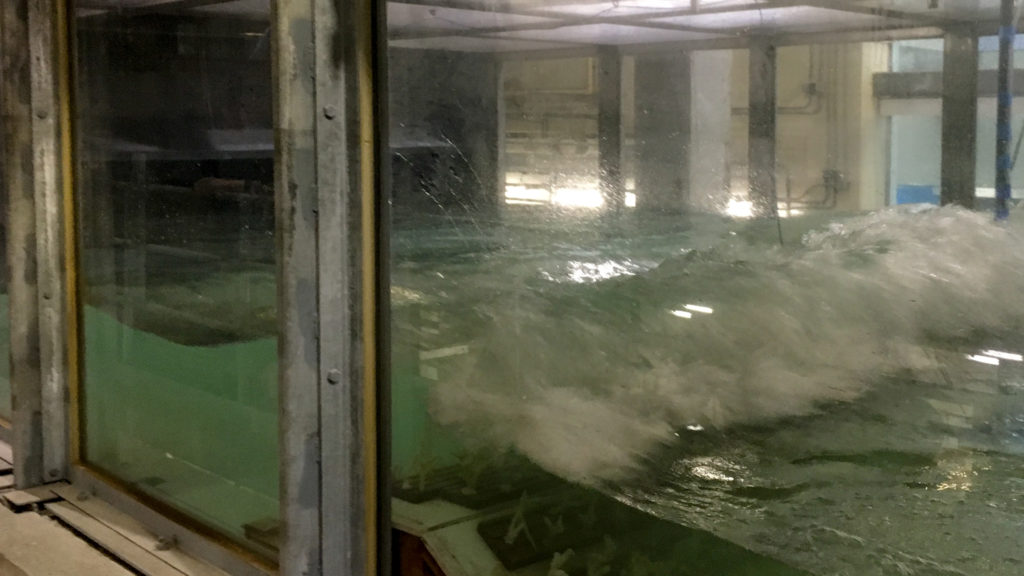Hurricane Ready: Researchers on Virginia Key Inch Closer to Unlocking Storm Secrets
Annali HaywardMay 27, 2019

Researchers simulate the wave action of a hurricane at the SUSTAIN lab, operated by the University of Miami’s Rosenstiel School, May 23, 2019 (Key News/Annali Hayward)
Across Bear Cut Bridge, in a high-tech building overlooking the Seaquarium, specialists from the UM Rosentiel School of Marine and Atmospheric Science go about their business. Today, they’re generating Category 5 hurricane winds — indoors.
Storm in a Tank
The SUSTAIN Lab (Surge-Structure-Atmosphere-Interaction) opened in 2014, and is the largest wind-wave tank in the world. Inside this 75-foot acrylic structure, tonnes of seawater can be whipped into a white-peaked frenzy in mere minutes. Equipment inside measures wind speed, wave height, and atmospheric pressure.
“At speeds of up to 160 miles per hour, SUSTAIN is the highest wind speed facility in the world,” says Brian Haus, professor and chair of the school’s Department of Ocean Sciences, who leads the team’s efforts to help demystify storms.
Storm research is often pigeonholed as merely predicting the paths of systems. But that’s a different process, says Joel Amendolara, a graduate student in ocean engineering who helped whip up today’s heart-pounding demonstration.
Instead, part of what Haus and his team focus on is storm intensification: how rapidly a tropical storm develops into the next category (on the Saffir-Simpson scale).
“If we can say whether it’s going to be a Category 2 or a Category 5 approaching you – that’s a pretty big difference!” says Haus.
Investigating Intensity
Taking heavy, expensive equipment into the eye of a hurricane is not an easy way to figure out how it behaves. With the SUSTAIN lab, researchers can observe the often centimeter – scale behaviors in a controlled way – and crucially, with saltwater.
That’s how they found a far higher number of big bubbles in the air during a storm than previously thought. The team believes more droplets could be adding energy, thus aiding heat transfer and quickening a storm’s intensification.
Another area of focus is the impact of friction on the ocean’s surface – a discovery the team calls the “drag co-efficient.”
“It’s a way to look at how energy transfers in a storm. Heat transfer provides energy – but friction causes a storm to lose it,” explains Haus.
Scientists previously thought drag increased in correspondence with wind speed, but the team found it levels off after winds of around 30mph. It’s ongoing work, but “with our lab we can start to look at what happens in the higher wind speeds of an intense Cat-5 storm,” says Haus.
Both of these types of findings can be plugged into forecast models and used to help communities prepare faster and more effectively for approaching systems.
Coastal Strategies
The other key focus for the interdisciplinary research at the Lab is coastal resiliency, something close to the hearts of many Key Biscayners after Irma’s near-miss.
SUSTAIN takes an interdisciplinary approach, working with colleagues from the University’s civil, ocean and environmental engineering departments to test “green infrastructures” like coral reefs under storm conditions.
“Coral reefs can dissipate up to ninety percent of the energy in a wave — thirty percent if it is submerged,” says Haus. The question for the researchers is at what depths these natural structures have an impact, and how much: “then we can figure out how to optimize it.” They will test their theory off Miami Beach next summer.
Dr. Landolf Rhode-Barbarigos, an assistant engineering professor, says we must continue to “act on different levels” when it comes to protecting our coastal structures from the forces applied by storms. “We cannot guarantee a certain level of protection,” he says of the continuing need for harder interventions like sea walls.
Haus agrees, noting that since corals can regenerate over time, as well as provide other benefits (such as for marine life and tourism) they may well be a more cost-effective and efficient defense.
Climate of Change
There is an urgency about the work here at the SUSTAIN lab.
“Miami and Miami Beach are already at ground zero for the effects of climate change and sea-level rise,” says Amendolara.
“We can no longer just rely on publishing a paper, that’s morally not enough in my view,” affirms Haus, who advocates “getting the science out there” to lobby officials and get the right policies in place.
“The impact of having more warm water available to power storms is pretty clear,” he continues. “It’s a dangerous thing to do to ignore the science. It’s not a matter of belief, it’s just facts.”
Although the NOAA predicts a relatively normal hurricane season for 2019, this year marks the record fifth in a row where a tropical storm has developed before its season’s official start date. Subtropical Storm Andrea opened proceedings on 20 May, almost two weeks prior to the 1 June date.



Responses
Ferna Jones
May 28
Keep on building on every little piece of green in Florida. Let people keep on using their old septic tanks. Keep throwing plastic and sewage in the water, and changing the way the water used to flow through the Everglades. Florida is nearly ruined now!!
The comments are closed.